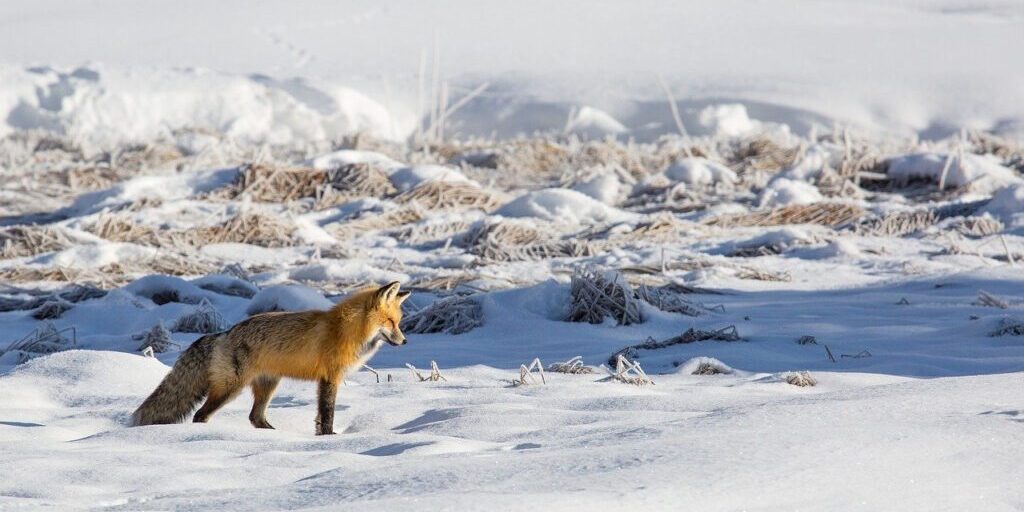If you live within Nome city limits, you may have seen foxes running around town recently. The Alaska Department of Fish & Game doesn’t know exactly how many red or arctic foxes there are locally, but says it’s likely the population is increasing along with its potential to transmit rabies.
KNOM’s Davis Hovey reports on what you can do to avoid encounters with rabid foxes.
Utqiavik on the North Slope recently lifted a citywide rabies quarantine that was in effect for three-weeks after an infected fox bit a local dog.
Although no incidents of fox bites have been reported further south on the Seward Peninsula, concerns over rabid foxes have spread to Nome, according to City Councilmember Jennifer Reader. She asked the Nome City Council recently if the city’s Animal Control Officer could do anything about these sly creatures.
“Do her (Emily Stotts) duties include non-domesticated animals like the fox I keep finding on my porch, and other people too? It sounds like that’s a major concern right now for our community.”
– Jennifer Reader
City manager Glen Steckmann replied they are exploring their options for fox control, but the current ACO contracting with the City, Emily Stotts, may not be the answer.
“We’re looking into that but typically, from what I understand, the Animal Control Officer has only dealt with dogs and cats.”
Trapping foxes under a permit is an option within Nome, although it is limited in certain areas near city limits. Nome city code states that individuals wishing to trap animals in Nome must fill out a registration permit and follow city and ADF&G regulations. Hunting and trapping seasons for foxes are currently underway until the spring.
ADF&G regulations in Unit 22 say the hunting season for foxes harvested with a hunting license is Sept 1-Mar 15 with a bag limit of 2 arctic foxes and 10 red foxes. The trapping season for both red foxes and arctic foxes is Nov 1-Apr 15 with no limit on the total number of foxes of either species taken under the trapping regulations with a trapping license.
A potential option, Unit 22 area biologist for Fish & Game Bill Dunker says, is ADF&G can respond to reports of rabid foxes on a case-by-case basis, if they receive any.
According to an ADF&G veterinarian, who tracks foxes infected with rabies statewide, there have been no such cases reported in Nome recently.
“So the State Virology Lab keeps me informed of any positive cases in wildlife So I just got an email today, confirming that a fox sent in from Gambell was positive.”
– Kimberlee Beckman
Kimberlee Beckman, the wildlife health veterinarian with ADF&G, received that report on Wednesday morning and she says no one in Gambell was bitten by this particular arctic fox.
“It was found in a shed with a couple of dogs, so it’s assumed that the dogs might have had exposure, but it did not bite any people.”
– Kimberlee Beckman
Although arctic foxes are predominantly the carriers of the rabies variant, as in this latest case in Gambell, Beckman says more and more cases of rabies in red foxes are showing up. The obvious difference between the two is implied by the name, red foxes have reddish colored fur while arctic foxes have white fur.
But Beckman explains, there are other characteristics that separate the two.
“Arctic fox are smaller and usually shyer, and red fox do really well around human populations. So the important thing is not to let them get into garbage, not to leave garbage out, or anything that they can get to.”
Beckman says the arctic fox population on the North Slope and in Western parts of the state seem to have more cases of rabies this year, indicating what is called an epizootic.
“These epizootics occur every about 5 to 10 years, and it occurs the year after a lemming high. So, when there’s a lot of lemmings around, the foxes breed more, have more pups, and that puts more susceptible foxes in the population that don’t have prior exposure and don’t have any antibodies. And that’s what sets up an epizootic and that’s what it looks like is happening this year.”
Dunker from the Nome Fish & Game office says they do not have estimates for the fox population in the Nome area, and they have not received any reports locally of rabid foxes. The department does encourage the public to report any fox behaving unusually or exhibiting signs typical with rabies.
Still, in order to prevent unwanted encounters with foxes, rabid or not, Dunker and Beckman agree that trash containers need to be closed and made inaccessible to these animals.
In addition, Beckman says one of the most important measures to take for rabies prevention, is to get your pets vaccinated and keep their rabies’ vaccines up to date.
“Because the number one exposure risk for people and children is from dogs that have interacted with a fox, so it’s usually a rabid fox that transmits rabies to the dog, and then the dog is the one who exposes the family.”
If you are bitten by a fox or other animal and suspect rabies, clean the wound thoroughly with soap and water, and then contact your local health care provider immediately.
You can also call the State section of epidemiology for more information at 907-269-8000. If you have reports about rabid foxes in Nome, please call 443-8503 or the Nome ADF&G office.
Image at top: Red fox in Alaska. Photo in the public domain, via Pixabay.




